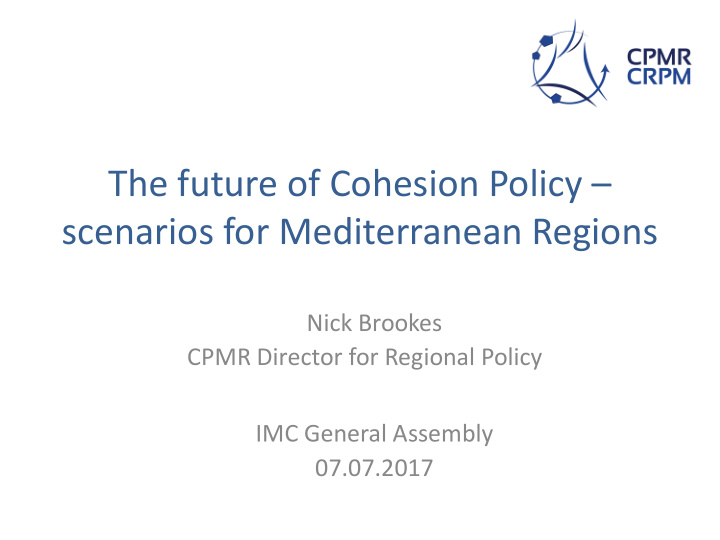



The future of Cohesion Policy – scenarios for Mediterranean Regions Nick Brookes CPMR Director for Regional Policy IMC General Assembly 07.07.2017
Plan of presentation • Analysis on the future of Cohesion Policy for post- 2020 from the point of view of Mediterranean regions • Views and positions from the CPMR • Actions for the future
The future of Cohesion Policy (I) Analysis based on EU finances reflection paper and recent contacts with DG REGIO The ‘certainties’: • There will be a - smaller - Cohesion Policy after 2020 • Cohesion Policy will exist in a ‘supporting’ role (esp. for the European Semester) • Appetite for significant reform : differentiation, simplification, co-financing rates… • The European Fund for Strategic Investment (EFSI) is here to stay, better complementarity with Cohesion Policy • Reinforcement of some territorial instruments (S3, ITIs)
The future of Cohesion Policy (II) The ‘unknowns’: • Will the policy cover all regions ? • Allocation of funds and based on which criteria? • 5 European Structural and Investment (ESI) funds or a single investment fund? • Which investment areas and priorities? Perhaps more on: – migration: integration measures, solidarity mechanism – appetite for more focus on social issues – territorial cooperation: support for stronger ETC, proposal to integrate cross border programmes within transnational programmes – more focus on urban
Views and positions from CPMR (I) Comparison with adopted CPMR policy position on future of Cohesion Policy (22 June 2017) We support: • Recognition of the limits of financial instruments vs grants (e.g CPMR study) • Recognition of complementarity between EFSI and Cohesion Policy • Recognition of the need for more positive incentives vs sanctions (e.g macroeconomic conditionality) • Some ideas on simplification (designation authorities, single set of rules for ESI funds…)
Views and positions from CPMR (II) We oppose: • the absence of a strategic vision for Cohesion Policy supporting a Europe 2030 strategy • the absence of mention of territorial dimension of Cohesion Policy (and specific territories such as islands ) • the lack of recognition of role played by regions • the absence of plans for state aids reform to ease Cohesion Policy implementation • the lack of a guarantee that Cohesion Policy will cover all 5 ESI funds (and in particular the European Social Fund)
Views and positions from CPMR (III) We are unsure about: • the idea of ‘Structural Reforms Contract’ (e.g better cofinancing rate if Member State implements country specific recommendations) • a single category of regions for Cohesion Policy • a ‘results-based’ payment approach • more concentration of priorities • alignment between territorial cooperation programmes and macroregional / sea basin strategies • the external EFSI (EIP) being fit for purpose (involvement of regions, adequate instrument for development policy)
Next steps By the end of 2017/early 2018: • Lobbying initiatives to secure strong Cohesion Policy for post-2020, ‘sell’ CPMR key proposals to ‘non-believers’ • Develop technical scenarios for post-2020 EU Budget and Cohesion Policy for the CPMR October 2017 AGM: – Single category of regions – New indicators for Cohesion Policy allocation methodology – Single investment fund – Timing of post-2020 MFF publication and agreement Leading on the Commission proposals for post-2020 EU Budget and Cohesion Policy in 2018/2019!
Many thanks for your attention! Nick Brookes CPMR Director nick.brookes@crpm.org www.cpmr.org
Recommend
More recommend